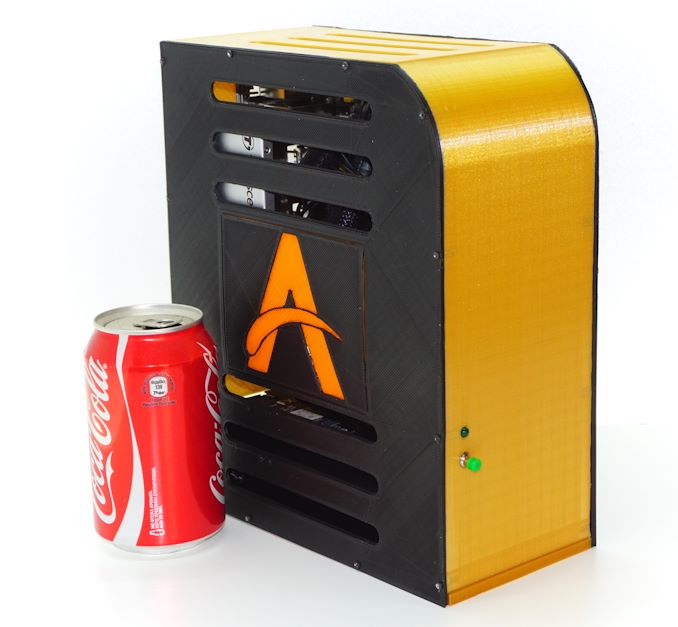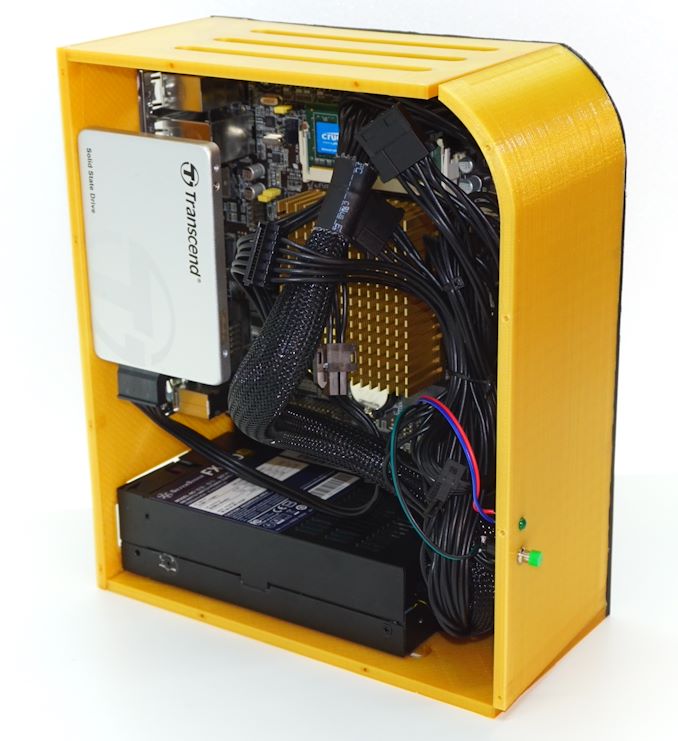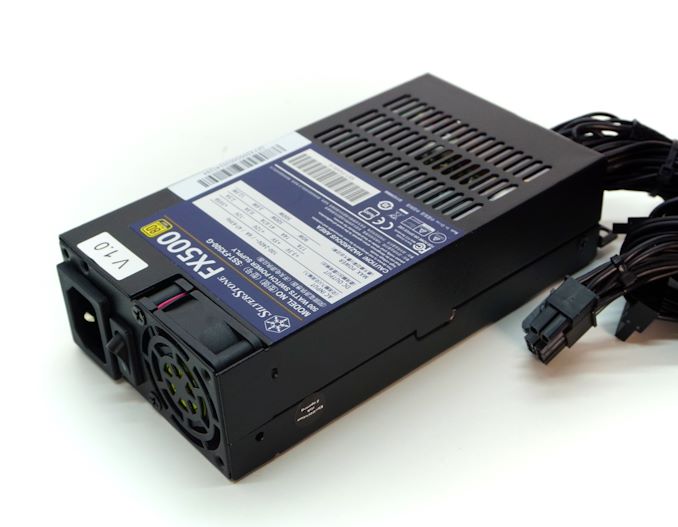The SilverStone FX500 Flex-ATX 500W PSU Review: Small Power Supply With a Big Bark
by E. Fylladitakis on November 12, 2020 9:00 AM EST- Posted in
- Cases/Cooling/PSUs
- PSUs
- 80Plus Gold
- SilverStone
- 500W
- Flex ATX
Final Words
SilverStone’s FX500 sits on a unique pedestal in the retail market, as it is one of the only high performance and high output Flex ATX power supply currently available. Still, if we do not count 1U server applications, the demand for Flex ATX units is low, limited to just enthusiasts and modders who want to build very small (and frequently custom) systems. For those situations, the proportions of the PSU allow for the easy design and fabrication of 3D printed enclosures using widely available consumer FDM 3D printers.
In terms of quality, the SilverStone FX500 is a well-designed and made power supply. Channel-Well Technologies is a reputable OEM whose designs we frequently encounter in advanced PC PSUs, and SilverStone ensured that the FX500 is assembled with fine quality components, the combination of which should result in a highly reliable product. Considering that these platforms were originally intended to power 1U servers 24/7, the longevity of the FX500 is pretty much assured.
The performance of the SilverStone FX500 left us with mixed feelings, however. On the upside, the electrical performance of the PSU is very good, especially after taking into account the massive space restrictions that the designers had to deal with. It delivers good power quality and the efficiency is just as high as advertised. However the thermal performance is practically incomparable to that of more typical ATX PSUs and, as one would expect for such a compact PSU, thermal stress became an issue while the unit was operating inside our hotbox. This is an edge case for most users, as few people enjoy hanging out in rooms that are over 40 degrees Celsius, but it goes to show how the PSU's cooling is right on the knife's edge. Nevertheless, the FX500 was able to perform normally even when its internal temperature was very high, only finally stopping once forced to shut down by its protective circuitry.
Unfortunately the counterpart to thermals – noise – proved to be a bigger concern, and we believe that this is the the Achilles' heel of the SilverStone FX500. Put simply, the PSU is noisy, which generally rules out using it in any kind of household computer. Most people will find the noise generated by the 40 mm fan intolerable even while the system is idling, and under high loads it is noticeable even through headphones.
Ultimately, this kind of noise would not a problem for server applications, but it is one of the prime deciding factors for home users. Which is why we believe that it greatly limits the market potential of the FX500; there just aren't very many scenarios where a loud PSU is okay in the consumer space. In the meantime, we are hopeful that SilverStone can learn from the FX500 and future Flex ATX implementations will be able to better balance their power output with their thermal performance, and ultimately offer home PC builders quieter power supplies.














35 Comments
View All Comments
Lucky Stripes 99 - Friday, November 13, 2020 - link
I'm curious how the other cooling components in a SFF case would react to having a passive AC-DC PSU like that running at high loads. You might just be pushing the noise and heat issues to other parts of the case. It may be an acceptable trade-off if they can do the job more quietly, but it may not turn out as quiet as you might hope. For the price, there are better alternatives.plewis00 - Thursday, November 12, 2020 - link
Is this actually that impressive for size? How does it compare to an HP 1200W server PSU? Yes I know those are loud (at full load but manageable at low load) and 12V-only but they’re capable of 1200W sustained at 240V and Platinum-rated. So is this Silverstone that much of a feat?thecoolnessrune - Thursday, November 12, 2020 - link
Yes, I would definitely say it's still impressive. The Flex-ATX PSU is around 150mm long. Those 1U Server PSUs are over twice that, usually in the 330mm range. That leaves a lot more room more more circuity to get efficiency up in the Titanium range, and leaves a huge amount of room for heatsinking in the path of the air channel. In addition to that, the server PSU has an edge finger connector vs having to solder wires onto the PCB, further decreasing the real estate needed for functions that don't involve cooling the unit. A last point is that most of these modern server PSUs do not have the further conversion circuity for 5V and 3.3V busses. They outboard that to the Power Management Module. I'd say it's pretty impressive that they were able to cram wiring, low voltage conversion circuitry, and a ~450W power output in a 150mm chassis length. But it definitely came at a cost. An extra 50mm of length would have made a world of difference.plewis00 - Thursday, November 12, 2020 - link
Where on earth did you get the dimensions from? I just pulled one of the HP Common Slot PSUs from a Proliant in the office and it’s not that large - HP says they’re 3.81 x 8.63 x 19.05 cm which is not a lot bigger - and they can go up to 1200W. Yes they’re a bit larger and they don’t have wires but the edge connector takes up similar space to directly connected wires. They’re missing 5 and 3.3V rails but how much space do they take? A slightly larger PSU that is highly efficient and has a much higher wattage seems to be similar ballpark to me.versesuvius - Thursday, November 12, 2020 - link
Could you please read what you write at least once before publishing it? This kind of writing is becoming a trend in Anandtech (sign of the times?):"As a result, SilverStone one of the very few companies with true a variety of small form factor power and cooling solutions, rather than just a token device or two."
ElectroChem - Thursday, November 12, 2020 - link
The previous sentence is no better."It's a field that SilverStone has become so entrenched in that although other companies that produce compact PCs and related peripherals as well[sic[ , none of them as [sic[ really trying to be SilverStone's peer."
Would it kill them to hire a proof-reader?
justaviking - Thursday, November 12, 2020 - link
As long as we are on this topic... maybe it's just me, but...Page 1, third paragraph...
You wrote: "making company PSUs an underserved market"
Did you mean to say... *compact* PSUs...?
Ryan Smith - Friday, November 13, 2020 - link
Thanks guys!Ej24 - Thursday, November 12, 2020 - link
Wonder if you could easily swap that fan for a 40mm x 20mm noctua? That'd probably move just as much air and be quieter. Don't have a need for such a tiny psu. But I'm sure I could dream of a need lolLucky Stripes 99 - Thursday, November 12, 2020 - link
Just be mindful of the static pressure and air movement rating of the original fan and any replacement you purchase. You can probably shave a few db off with a Noctua versus stock, but I wouldn't expect miracles.